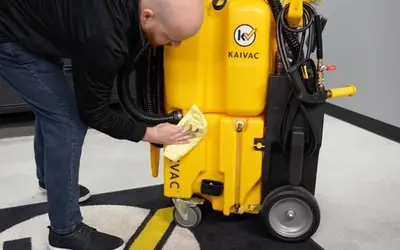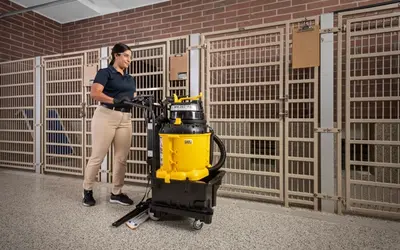Tips for an Odor-Free Pet Care Facility

Customers judge the quality of a pet care facility with their nose first. Of course, unpleasant smells are a reality of any pet care business, but strong, pervasive odors will make clients wonder about the quality of care their pets will get. That also goes for a big whiff of chemical air freshener or bleach, which smells like a quick cover up to a bigger problem.
A fresh smelling facility, however, signals a well-run business and trustworthy employees. Don’t believe it? Check out how often smell, either good or bad, is mentioned in online reviews of doggy day cares, animal shelters and vet offices.
Is your business up to snuff? Follow these tips for an odor-free pet care facility for happier clients and healthier pets.
Bad Smells in a Pet Care Facility
There’s a lot of sources to blame for bad smells in a pet care facility. The first source is pretty obvious: animal waste. Urine and feces smell bad by design. But just collecting and disposing of the waste may not be enough.
That’s because the bacteria that feeds on waste, particularly urine, also smells bad. Worse in fact, than the waste itself. These bacteria thrive and multiply in warm pet care facilities, creating malodors that can be difficult to fully remove.
Mold and mildew are another source of bad smells in your pet care facility. The spores can grow on nearly anything as long as there is enough moisture to support them and emit a distinctive, musty odor.
Pets can smell stinky all on their own. Everyone’s familiar with ‘wet dog smell.’ That funky odor comes from the yeast and bacteria that live in dog fur. The organisms are catalyzed by water and compounded by body heat into a nasty, pervasive potpourri according to an article by the Washington Post. But dogs don’t even have to get wet to start stinking. Stress can also induce pets to emit bad odors.
Even pet food can smell pretty gnarly. Designed to be appealing to dog and cat palettes, pet food often has a strong odor that’s unpleasant to the human nose. Spoiled food will only amplify the stink.
Venting for Odor Control
Luckily there are ways to combat the funk and create a fresh, odor-free pet care facility.
Start with the ventilation system. Bacteria and mold need moisture to thrive and a poorly functioning ventilation system allows moisture to accumulate in the environment. A well running ventilation/HVAC system will decrease relative humidity by exchanging moist, smelly air for fresh outside air.
Keep your HVAC system in good running order by changing filters on a regular schedule and servicing as needed.
Even the most powerful HVAC system can’t combat all of the moisture in a pet care facility, or remove all of the smells. For that you need a well-defined maintenance protocol that includes cleaning, drying and disinfecting the space.
How to Clean for Odor Control
Proper pet care facility cleaning and disinfecting are the only way to remove offending bacteria and molds. Start by moving animals to a separate holding area. Remove any toys, bedding and feeding bowls. Non-porous items can be soaked in a diluted disinfectant solution and run through a dishwasher. Soft, porous toys and blankets should be washed in washing machine.
Remove all solid waste, tracked in dirt and hair from the space. Surfaces, especially those contaminated with fluids must be cleaned with detergent before applying disinfectant. Don’t forget the corners, walls and ceilings. Rinse with hot water.
Choose the appropriate disinfecting agents. The UC Davis Koret shelter medicine website provides a list of appropriate, animal safe disinfectants. The site warns that using these products incorrectly can cause harm or death in boarded animals. Read and follow manufacturer directions carefully.
Apply solution, scrub and let dwell as directed. Rinse. If you’re lucky, your pet facility was designed with floor drains. If not, you will have to manually capture and remove rinse water.
Better Tools for Better Cleaning
Using mops, rags and water hoses for this job takes time and extra effort. Even worse, it will be nearly impossible to remove all of the bacteria, molds and other contaminants that make pet care facilities smell bad because mops are not good at removing dirt and germs.
In fact, mops can make smells worse by depositing dirty water directly on the offending bacteria.
Smart pet facility owners use a Kaivac No-Touch Cleaning System instead. This all-in-on technology can be used for quick clean up of unexpected messes, daily maintenance or weekly deeper cleans. Cleaning chemicals and disinfectants are metered to avoid overuse and there’s no risk of cross-contamination like with mops or cloths.
The No-Touch Cleaning System even vacuums dirty water away leaving surfaces clean, dry and ready to use.
Learn more about proper cleaning of kennels for your own odor-free pet care facility.
Related Posts

Preventive Maintenance for Your No-Touch Cleaning® System
Your Kaivac No-Touch Cleaning system makes restroom maintenance fast and easy. Keeping your No-Touch Cleaning system in good working order is also fast and easy. Kaivac makes performing preventative maintenance and troubleshooting potential issues simple. No special equipment or technical expertise required.
Read more
The Best Dog Kennel Cleaning Equipment
There are ways to simplify the kennel cleaning process. Automatic kennel cleaning equipment can simplify the kennel cleaning process and can save hours of daily, back breaking labor–even for facilities without central drains.
Read more
A Better Retail Floor Care Option: How One National Retailer Reclaimed Floor Care
Discover how a national retailer cut costs and improved results by switching to Kaivac’s All Floor™ system—an easy, all-in-one floor care solution perfect for low-revenue retail locations.
Read more